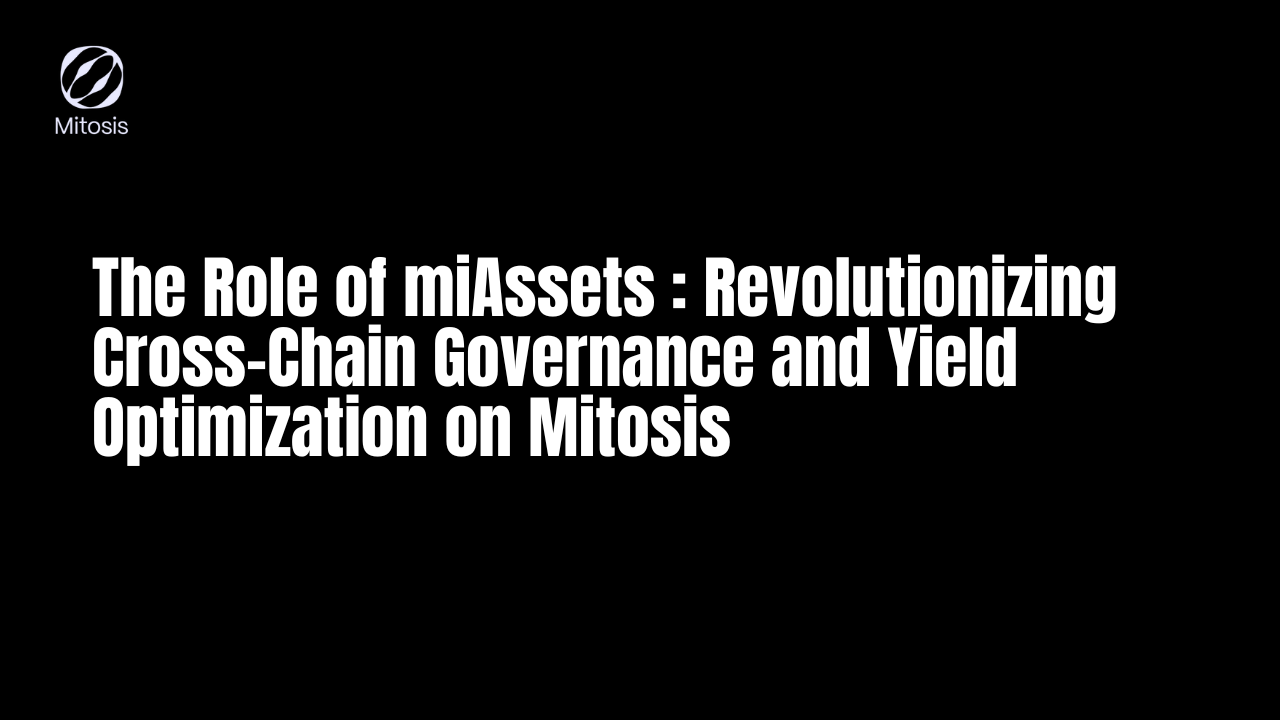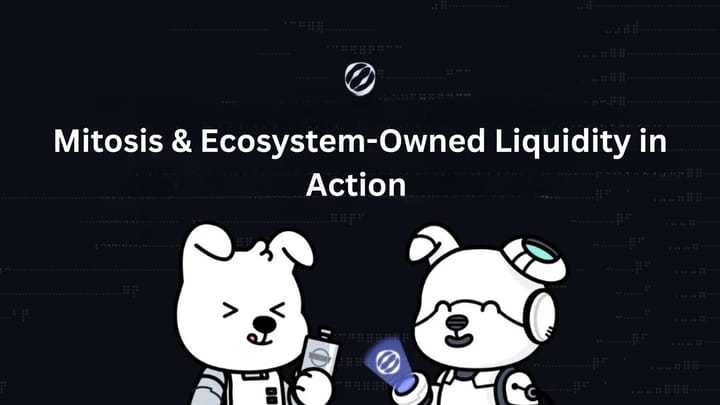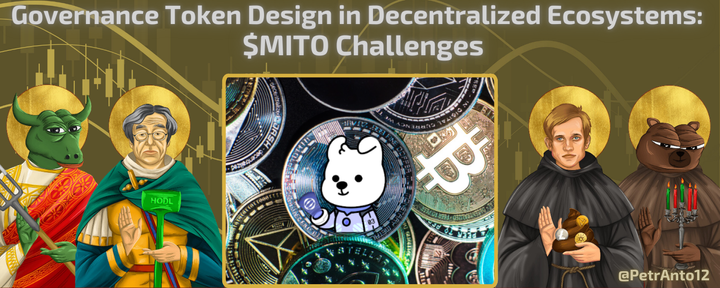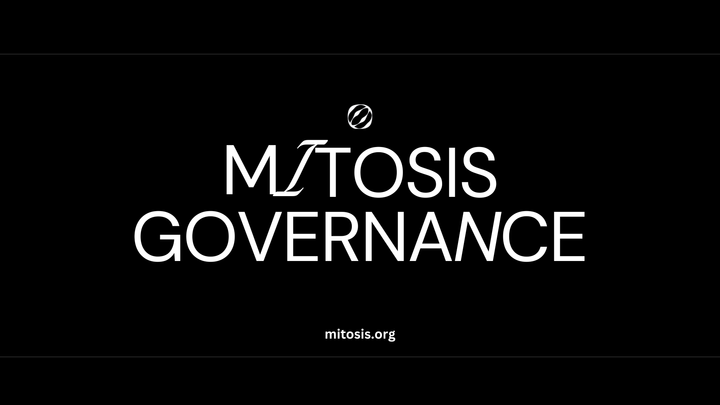The Role of miAssets in Revolutionizing Cross-Chain Governance and Yield Optimization on Mitosis

Introduction
Imagine a world where your cryptocurrency isn’t shackled to a single blockchain, where liquidity flows effortlessly across networks, and where governance isn’t just a privilege for the few but a right for the many. This isn’t a distant dream—it’s the reality being forged by Mitosis, a Layer 1 blockchain designed to unify decentralized finance (DeFi) through programmable liquidity. At the heart of this revolution lies miAssets, a groundbreaking token framework that’s transforming how we think about cross-chain governance and yield optimization. In an industry plagued by fragmented liquidity and siloed ecosystems, miAssets are the key to unlocking a seamless, efficient, and democratic DeFi future.
Mitosis tackles one of DeFi’s most persistent challenges: the inability of assets to move dynamically across blockchains without losing utility or incurring inefficiencies. With miAssets, liquidity providers (LPs) gain unprecedented control over their capital, participating in governance decisions that span multiple chains and earning optimized yields from diverse sources. This article explores the pivotal role of miAssets in revolutionizing cross-chain governance and yield optimization on Mitosis, diving into their mechanics, their impact on ecosystem-wide decision-making, and their ability to maximize returns in a multi-chain world.
What are miAssets?
miAssets are tokenized representations of assets deposited into Mitosis Vaults, minted at a 1:1 ratio with the underlying assets (e.g., deposit ETH, receive miETH). Unlike traditional cross-chain solutions that lock assets in bridges or wrap them into less versatile derivatives, miAssets remain liquid and programmable. They serve as a bridge between chains, enabling assets to retain their utility while participating in the Mitosis ecosystem. This is made possible through Mitosis’s partnership with Hyperlane, which ensures permissionless interoperability, allowing miAssets to move seamlessly across supported networks like Ethereum, Arbitrum, and Optimism.
Let's look into the role of miAssets in revolutionizing cross-chain governance and yield optimization on Mitosis
The Role of miAssets in Revolutionizing Cross-chain governance and Yield Optimization on Mitosis
The Power of Programmability
What sets miAssets apart is their programmability. These tokens aren’t static; they’re dynamic tools that LPs can use in various DeFi applications on the Mitosis L1 chain. For example, an LP holding miETH can stake it in a lending protocol, use it as collateral, or trade it—all while earning yield from cross-chain activities. This flexibility eliminates the capital inefficiency of traditional liquidity pools, where assets often sit idle. By tokenizing liquidity positions, miAssets turn passive deposits into active, yield-generating instruments.
Example: Consider a user depositing 10 ETH into a Mitosis Vault on Ethereum. They receive 10 miETH, which they can then opt into the Ecosystem-Owned Liquidity (EOL) Vault. Once in EOL, their miETH accrues “omni-sourced yield”—returns generated from liquidity allocation across multiple chains, such as lending on Avalanche or trading on Solana-based AMMs. This user doesn’t need to manually bridge their assets or navigate complex workflows; miAssets and Mitosis handle the heavy lifting, optimizing their capital across ecosystems.
Cross-Chain Governance—Democratizing Decision-Making with miAssets
One of the most revolutionary aspects of miAssets is their role in cross-chain governance. In the Mitosis ecosystem, miAssets grant holders voting power proportional to their stake, allowing them to influence how liquidity is allocated across supported networks. This is a game-changer in a DeFi landscape where governance is often confined to a single chain or dominated by large players. With miAssets, a retail LP holding miETH on Ethereum can vote on proposals affecting protocols on Avalanche, effectively breaking down the silos that have long hindered collaborative decision-making.
The EOL Framework
The Ecosystem-Owned Liquidity (EOL) model is the backbone of this governance system. LPs who opt into EOL agree to let the ecosystem allocate their assets to various yield sources based on community votes. In return, they receive miAssets, which double as governance tokens. This collective management approach aggregates individual deposits into a powerful liquidity pool, giving smaller LPs access to institutional-grade opportunities. For instance, a governance vote might decide to deploy $50 million in pooled ETH to a high-yield lending protocol on Arbitrum, a decision that benefits all miAsset holders regardless of their initial deposit size.
Case Study: In July 2024, Mitosis launched an LP campaign called “Expedition,” where participants deposited assets into Mitosis Vaults and received miAssets. Early data showed that over 60% of participants were retail LPs with deposits under $10,000. Through miAssets, these users collectively influenced the allocation of over $20 million in liquidity across eight chains, including Blast and Linea. This democratization of governance—enabled by miAssets—ensured that retail participants weren’t sidelined by whales, a common issue in traditional DeFi protocols
Yield Optimization—Maximizing Returns in a Multi-Chain World
Yield optimization is where miAssets truly shines. By default, miAssets accrue omni-sourced yield, meaning they generate returns from multiple chains without requiring LPs to manage each position individually. This is achieved through Mitosis’s sophisticated settlement system, which tracks yields, losses, and rewards across networks in real time. Algorithms then dynamically rebalance liquidity to capitalize on the highest-yield opportunities, ensuring capital efficiency.
Imagine an LP deposits 100 USDC into a Mitosis Vault on Optimism. They receive 100 miUSDC, which they stake in the EOL Vault. Over the next month, Mitosis’s governance allocates this liquidity to a stablecoin lending pool on Avalanche (yielding 8% APY) and a liquidity pool on Arbitrum (yielding 5% APY plus protocol tokens). The LP earns a blended yield of 7%, paid out in USDC, without ever leaving the Mitosis ecosystem. Compare this to traditional DeFi, where the same LP would need to bridge assets manually, incurring fees and risks, to achieve similar diversification.
Conclusion
miAssets are more than just tokens; they’re the linchpin of Mitosis’s vision to unify DeFi across blockchains. By bridging chains with programmable liquidity, they empower users to govern ecosystems collaboratively and optimize yields like never before. From enabling retail LPs to influence multi-million-dollar decisions to delivering omni-sourced returns that outpace traditional strategies, miAssets are redefining what’s possible in a fragmented industry. As Mitosis continues to expand—supporting more assets, integrating CosmWasm contracts, and nearing its mainnet launch—the role of miAssets will only grow, cementing their place as a cornerstone of the next generation of decentralized finance. In a world of silos, miAssets are the bridge to a connected, efficient, and equitable DeFi landscape.
Key Takeaways
- Programmable Liquidity: miAssets transform deposited assets into liquid, versatile tokens that can be used across DeFi applications while earning cross-chain yields.
- Cross-Chain Governance: miAssets empower LPs, including retail users, to vote on liquidity allocation across multiple blockchains, democratizing decision-making.
- Yield Optimization: Through omni-sourced yield and dynamic rebalancing, miAssets deliver 20-30% higher returns compared to single-chain strategies.
For more details on Mitosis, check the links below
Website || X || Discord || Telegram || Mitosis University || Glossary



Comments ()